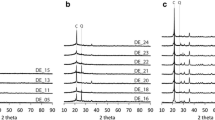Abstract
Soman is one of the most toxic nerve agents of the known chemical warfare agents. There is actually few knowledge on the behavior of soman in the event of an environmental contamination. It is in particular unknown whether soman remains on a given surface, evaporates into air, or degrades. Here, we studied the evaporation of soman deposited on silica sand using a laboratory-sized wind tunnel, thermal desorption, and gas chromatography. We also investigated the degradation of soman on silica sand by 31phosphorus solid state magic angle spinning nuclear magnetic resonance and gas chromatography–mass spectrometry. Results show that a drop of soman on silica sand spreads laterally while evaporating. The maximum vapor concentration was found when the spreading of the soman drop was maximum on the surface. Simultaneously, soman was absorbed gradually into the pore of sand and degraded to O-pinacolyl-methylphosphonic acid following a pseudo-first-order rate reaction over weeks. To our best knowledge, this is the first report on the fate of soman in a sandy environment.




Similar content being viewed by others
References
Bandosz TJ, Laskoski M, Mahle J, Mogilevsky G, Peterson GW, Rossin JA, Wagner GW (2012) Reactions of VX, GD, and HD with Zr(OH)4: near instantaneous decontamination of VX. J Phys Chem C 116:11606–11614
Bartelt-Hunt SL, Barlaz MA, Knappe DRU, Kjeldsen P (2006) Fate of chemical warfare agents and toxic industrial chemicals in landfills. Environ Sci Technol 40:4219–4225
Brunauer S, Emmett PH, Teller E (1938) Adsorption of gases in multimolecular layers. J Am Chem Soc 60:309–319
Dabisch PA, Davis EA, Renner JA, Jakubowski EM, Mioduszewski RJ, Thomson SA (2008) Biomarkers of low-level exposure to soman vapor: comparison of fluoride regeneration to acetylcholinesterase inhibition. Inhal Toxicol 20:149–156
Gosetti F, Mazzucco E, Gennaro MC, Marengo E (2016) Contaminants in water: non-target UHPLC/MS analysis. Environ Chem Lett 14:51–65
Guo Z, Dong D, Hua X, Zhang L, Zhu S, Lan X, Liang D (2015) Cr and As decrease lindane sorption on river solids. Environ Chem Lett 13:111–116
Hambrook JL, Howells DJ, Utley D (1971) Degradation of phosphonates. breakdown of soman (O-pinacolyl-methylphosphonofluoridate) in wheat plants. Pestic Sci 2:172–175
Hoskovcova M, Halamek E, Kobliha Z, Kasalova I (2009) Proposal for selective differentiating of nerve agent G and V type with utilization of modified Ellman’s method. Environ Chem Lett 7:277–281
John EM, Shaike JM (2015) Chlorpyrifos: pollution and remediation. Environ Chem Lett 13:269–291
John H, Worek F, Thiermann H (2008) LC-MS-based procedures for monitoring of toxic organophosphorus compounds and verification of pesticide and nerve agent poisoning. Anal Bioanal Chem 391:97–116
Jung H, Lee HW (2015) Study on the initial evaporation rates of distilled sulphur mustard (HD) in concrete using wind tunnel and TD-GC/MSD: effect of drop size and temperature. Int J Environ Anal Chem 95(6):569–579
Kingery AF, He Allen (1995) The environmental fate of organophosphorus nerve agents: a review. Toxicol Environ Chem 47:155–184
Mizrahi DM, Columbus I (2005) 31P MAS NMR: a useful tool for the evaluation of VX natural weathering in various urban matrixes. Environ Sci Technol 39:8931–8935
Morita H, Yanagisawa N, Nakajima T, Midorikawa Y, Mimura S (1995) Sarin poisoning in Masumoto, Japan. Lancet 346:290–293
Munro NB, Talmage SS, Griffin GD, Waters LC, Watson AP, King JF, Hauschild V (1999) The sources, fate, and toxicity of chemical warfare agent degradation products. Environ Health Perspect 107(12):933–974
Nikitin MBD, Kerr PK, Feickert A (2013) Syria’s chemical weapons: issues for congress. Report #R42848
Suzuki T, Morita H, Ono K, Maekawa K, Nagai R, Yazaki Y (1995) Sarin poisoning in Tokyo subway. Lancet 345:980–981
Wagner GW, O’Connor RJ, Edwards JL, Brevett CAS (2004) Effect of drop size on the degradation of VX in concrete. Langmuir 20:7146–7150
Walton KS, Snurr RQ (2007) Applicability of the BET method for determining surface areas of microporous metal-organic frameworks. J Am Chem Soc 129:8552–8556
Yang YC (1999) Chemical detoxification of nerve agent VX. Acc Chem Res 32:109–115
Yang YC, Baker JA, Ward JR (1992) Decontamination of chemical warfare agents. Chem Rev 92(8):1729–1743
Yeung DT, Smith JR, Sweeney RE, Lenz DE, Cerasoli DM (2008) A gas chromatographic-mass spectrometric approach to examining stereoselective interaction of human plasma proteins with soman. J Anal Toxicol 32:86–91
Yokota T, Kiraga K, Yamane H (1975) Mass spectrometry of trimethylsilyl derivatives of gibberellin glucosides and glucosyl esters. Phytochem 14:1569–1574
Acknowledgments
The authors thank Chemical Analysis Test and Research Lab at Agency for Defense Development (ADD) for providing soman GD. We really thank the reviewers for their insightful comments on the paper.
Author information
Authors and Affiliations
Corresponding author
Rights and permissions
About this article
Cite this article
Jung, H., Lim, K.C. Fate and degradation of the chemical warfare agent soman on sands. Environ Chem Lett 14, 367–372 (2016). https://doi.org/10.1007/s10311-016-0575-1
Received:
Accepted:
Published:
Issue Date:
DOI: https://doi.org/10.1007/s10311-016-0575-1




